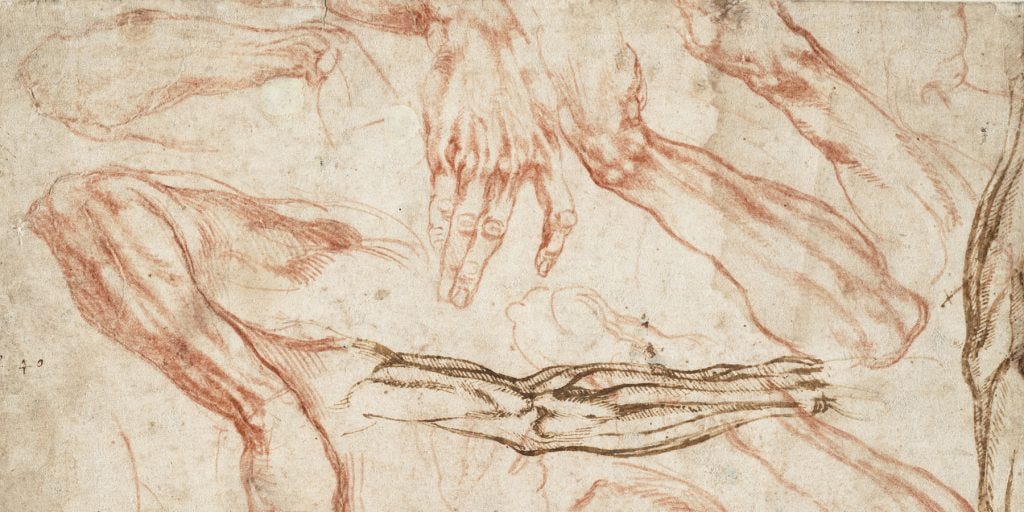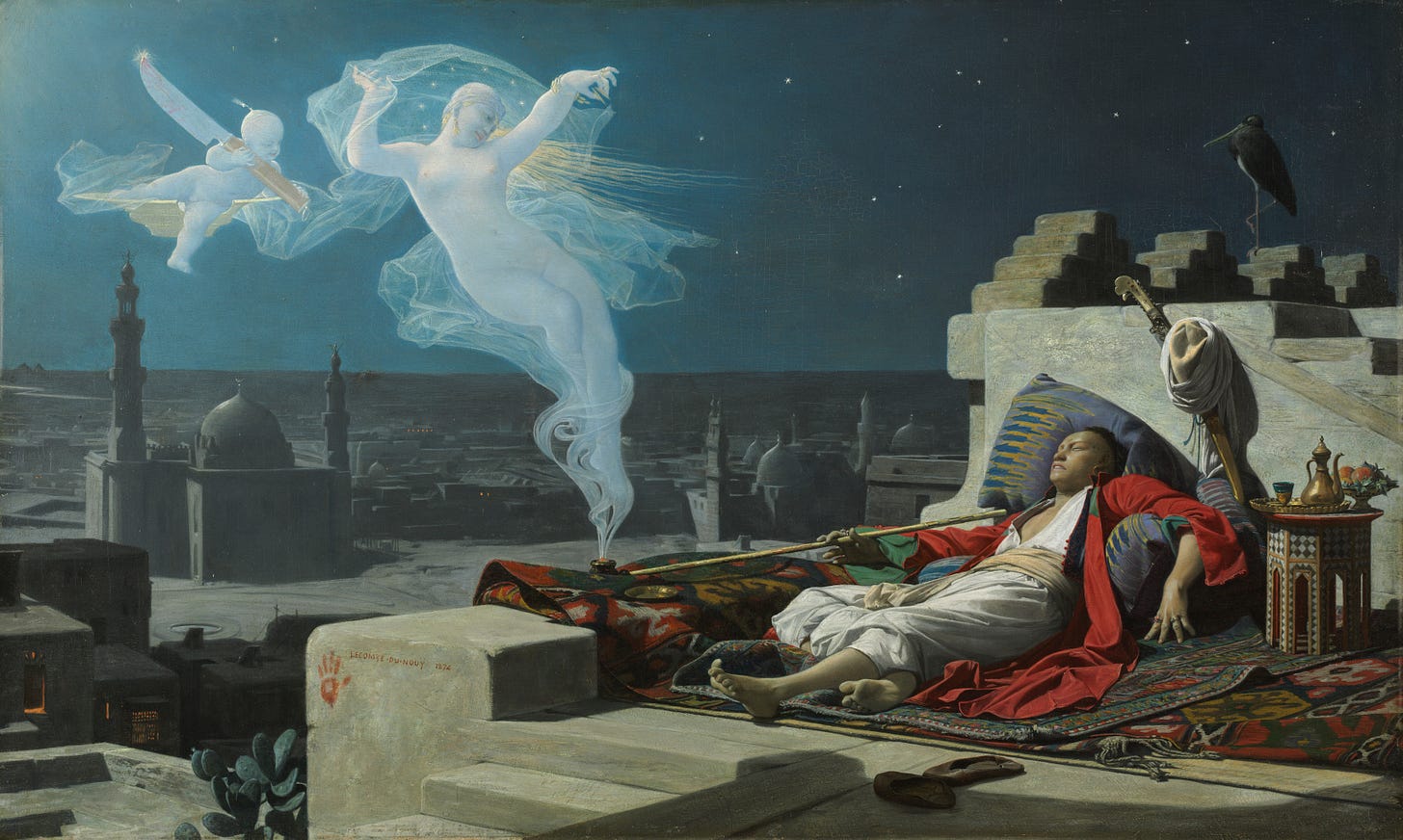Sensory Illusions, Phantom Limbs & Dream Avatars
"Dreams are fully immersive dissociative experiences."
Links to related written content and the podcast episodes that informed them, can be found at the bottom of this post.
Look at your arm. The image you see is not a direct readout of your arm. It’s what gets projected onto the screen of perception after substantial data processing. When you watch a well-produced video, you’re not seeing the raw data. That data was altered during post-production—the image was enhanced, sound normalized, certain bits spliced in and out. These separate data streams were also temporally aligned using some reference frame, so that the final product matched viewer expectations. Think of poorly produced footage, where speech sounds are misaligned to mouth movements.
Rubber Hands & Phantom Limbs
Perceptions are studio productions. You experience the final product, not the production steps. The “rubber arm illusion” is a method for hacking the brain to make this dramatically clear:
To work, the real and fake arms must be close together. The participant must look at the rubber arm with the real one obscured from view. The real and fake versions must then be touched simultaneously while the participant sees only the rubber one. All of these things conform to your brain’s expectations about “your arm.”
Eventually, there’s a perceptual shift. When you see the rubber arm touched, you experience an associated sensation. You also fail to report when your real arm is touched—you dissociate from that sensory input. The perception of physical touch is not created at the point of contact on your skin and beamed up to the brain. That experience is created within the brain after the touch data arrives. After that, it’s projected onto the visual image of “your arm”—even when it’s an image of a fake rubber one.
The body is one physically integrated unit, so the brain learns to expect specific patterns of multisensory correlation among body parts. This expectation is what the rubber arm illusion takes advantage of. By fooling the brain’s coincidence detection mechanisms, the rubber arm image gets labelled “you” somewhere in post-production. When you see “your” rubber hand being touched, it automatically activates a web multisensory associations, including the physical touch sensation.
A related phenomenon is seen in phantom limb syndrome, common among amputees. Similar to the rubber arm illusion, conscious perceptions are triggered by a limb that is not physically attached to the body. In this case, the memory of the limb is so firmly ingrained that a web of multisensory associations gets triggered even in the absence of the limb itself.
Here’s a video of a cat scratching its ear with a phantom limb:
Not only do amputees commonly experience phantom limbs, but their perceptions can be excruciating. In the worst cases, the missing limb is perceived to be stuck in an uncomfortable pose (often the one it was in when severed). This can sometimes be treated by using a “mirror box,” which achieves an effect similar to the rubber arm illusion:
With the rubber arm illusion, the brain renders the experience of “my arm” using the visual image of the rubber arm in the post-production process, dissociating this perception from the data stream sent by the real arm—they’re filtered out of the final cut. In phantom limb syndrome, the brain fails to dissociate from its stored image of the missing arm. In the absence of real-time input of an arm coming from the eye, it splices in whatever image was left in its perceptual editing suite. In both cases, the image of something not physically connected to the body is woven into the tapestry of lived experience.
Whether drug-induced or triggered by unusual sensory feedback, dissociative experiences feel weird even when we know what’s going on. Although most people will never be put into a dissociative state by drugs or contrived laboratory setups, dissociation is something we experience daily. We often just don’t realize it.
Everyday Dissociative States
Stop reading for a moment and notice. What parts of your sensory experience were you just oblivious to? The faint hum of an appliance, or sensations in the body? There’s probably something —something already there that your consciousness didn’t register. Sensory information was getting into the “bottom” of your nervous system, but was unable to get all the way “up” to the level of conscious perception.
A much more dramatic but no less familiar dissociative process happens to us when we transition between wakefulness and sleep: Dreaming. Think about how bizarre and illogical dreams are. Perhaps even more strange is that we don’t notice this while dreaming. We just go with the flow. To paraphrase the late, great Mitch Hedberg: “One minute I’m lying in bed, and the next thing you know I have to build a go-kart with my ex-landlord.”
Dreams are fully immersive dissociative experiences. The “you” in your dreams isn’t really you. It’s a dream avatar—an image of yourself constructed by the mind in the absence of real-time sensory input from your sense organs. Not unlike the phantom limbs experienced by amputees, the dream avatar is a phantom identity.
Waking up is the end of a dissociative process. When you wake up your dream avatar is toast. It's dead. You thought you were the dream avatar, but you never were. It's the same you that wakes up [who fell asleep]—then you remember the memories of your life, which “you” didn't remember when you were the dream avatar. -Bernardo Kastrup, M&M #60
Dream and waking consciousness involve distinct modes of cognition—conscious perceptions are generated in both states, but a different set of constraints govern how they cohere and unfold. For example, the dream avatar lacks meta-awareness. It has an experience but does not recognize or reflect on it. The exception to this is lucid dreaming, in which there is awareness of awareness and one can engage in acts of volition within the dream state. These unusual cases reinforce the fact that normal dream experiences lack this aspect of cognition.
As you would expect, each state of consciousness—waking, dreaming, and lucid dreaming—is accompanied by distinct patterns of brain activity:

The dream state is also amnesic. Our dream avatars don’t have the ability to recall waking memories. While dreams are composed of elements taken from waking consciousness, they appear in strange, recombined patterns not experienced while awake. Conversely, dreams are ephemeral to the waking mind. We often don’t remember dream content at all. When we do, the memory tends to slip away, like sand through our fingers.
(For more on the relationship between sleep and memory, see M&M #16)
Upon awakening, we return to the same identity we had before falling asleep. The software programs associated with waking consciousness, including meta-awareness and long-term memory recall, boot back up. This kind of cognitive landscape seems to be crucial for stable identity formation. By contrast, the dream world is a cognitive desert. Dream avatars are pseudo-identities—transient loci of awareness—assembled each night from whatever happens to be lying around the brain’s perceptual editing suite.
These everyday shifts in experiential state illustrate how different forms of consciousness can alternately trade places but remain largely dissociated from one another. Despite our daily excursions into the dream world, where perception is unsupervised by the narrative logic of waking cognition, we remain tethered to a singular identity—one enduring locus of awareness. This identity temporarily fades when we fall asleep and evolves over the lifespan, but a common denominator of you-ness is nonetheless projected onto every scene of remembered waking life.
Although uncommon, it is possible for a single brain to house multiple, stable waking identities, each one partially or completely dissociated from the others. Before understanding how identities within a single brain can become dissociated, we will need a better understanding of the biology underlying identity formation. This will come from studying self-perception at the molecular level.
To learn more about the topics covered in this essay, try these episodes of the Mind & Matter podcast:
Bernardo Kastrup: Consciousness, Dissociation, Idealism, Materialism, Psychedelics, Death & Mind | #60
Anil Seth: Consciousness, Perception, Hallucinations, Psychedelics, Selfhood, Neuroscience & "Being You" | #44
Bob Stickgold: Sleep, Dreams, Memory & the Brain | #16
Read other parts of the ‘What is Psychological Identity?’ series:







:) I look forward to part 4 :)